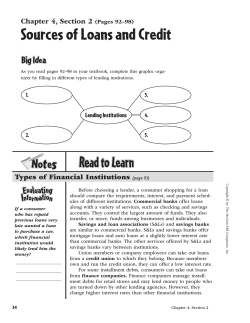
Credit Memorandum Example & Requirements for 7a
Credit Memorandum Example & Requirements for 7a Small Loans ($350,000 or Less) Cash-Flow Analysis Credit Score: 4506-T Verification: Note: Confirm in Lender credit memo collection of business tax returns, and verification and reconciliation of the applicant’s financial data against income tax data (received in response to IRS Form 4506-T, Request for Transcript of Tax Return) prior to submitting the application to SBA. Other Comments: Note: SBLC’s must follow SBA rules, since they do not have similarly sized non-SBA commercial loans. An acceptable credit score satisfies the requirement to consider the following: 1. The credit history of the applicant (and the Operating Company if applicable), its Associates, and guarantors, including historical performance as well as the potential for long term success (character and reputation will be determined through the appropriate questions on SBA Form 1919 and, if required, SBA Form 912); 2. The strength of the business; 3. Past earnings, projected cash flow, and future prospects; and 4. The applicant’s ability to repay the loan with earnings from the business. Business Analysis / Rational for Approval Business Type: Business History: Management Experience: Overall Financial Condition (if necessary): Equity Injection (if necessary): Pro-forma Debt to Worth Comments (if necessary): Impact of Affiliates (if applicable) Rational for Approval: Other Comments: The Lender’s credit memo must include the following: 1. A brief description of the history of the business; 2. A brief description of the management team of the company. Consider the length of time in business under current management and, if applicable, the depth of management experience in this industry or a related industry; 3. Owner/Guarantor analysis, including obtaining personal financial statements, consistent with lender’s similarly-sized non-SBA guaranteed commercial loans; 4. Confirmation of Lender’s collection of business tax returns and verification and reconciliation of the applicant’s financial data against income tax data (received in response to IRS Form 4506-T, Request for Transcript of Tax Return) prior to submitting the application to SBA; 5. Lender must determine if the equity and the pro-forma debt-to-worth are acceptable based on its policies and procedures for its similarly-sized, non-SBA guaranteed commercial loans. If the lender requires an equity injection and, as part of its policies and procedures for its similarly-sized, non-SBA guaranteed commercial loans verifies the equity injection, it must do so for SBA loans; 6. A list of collateral and its estimated value, if secured; and 7. The effect any affiliates may have on the ultimate repayment ability of the applicant. Collateral Analysis List of Collateral and values (if secured): Other Comments: Collateral Analysis: For 7a Small loans of $25,000 or less, lenders are not required to take collateral. For 7a Small loans over $25,000 and up to and including $350,000, the lender must follow the collateral policies and procedures that it has established and implemented for its similarly-sized non-SBA guaranteed commercial loans, but at a minimum the lender must obtain a 1 st lien on the purchased assets and a lien on the borrower’s fixed assets to secure the SBA-guaranteed loan. Other Analysis Comments on Eligibility, Franchise, Refinance, etc.: Other Analysis: Based on the lender’s underwriting process for similarly sized non-SBA commercial loans, it might include a discussion of any seller financing, standby agreements, derogatory credit (especially judgments and bankruptcy, and trade disputes); affiliates and franchise agreements; any additional information the lender considers relevant. For more details see Chapter 4 of SOP 50 10 5 Revised 8/2014 Sample Form – Not Required
© Copyright 2025









